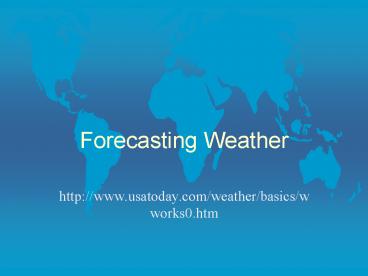Forecasting Weather - PowerPoint PPT Presentation
1 / 29
Title:
Forecasting Weather
Description:
Technology and Weather Forecasting Satellites photograph sections of the earth s surface and show cloud coverage Air Mass A large body of air that has the same ... – PowerPoint PPT presentation
Number of Views:527
Avg rating:3.0/5.0
Title: Forecasting Weather
1
Forecasting Weather
- http//www.usatoday.com/weather/basics/wworks0.htm
2
What are Fronts?
- A boundary between two air masses is called a
__Front_________ - The shape of the _Front_______ depends on the
density of the air masses and their speed
3
When a front forms
- Pressure falls when a front approaches (low
pressure edges of air masses move in) - Changes in wind direction occur. High pressure
air moves Clockwise, low pressure air moves
Counterclockwise - Temperature changes occur
- Precipitation occurs and can be in the form of
strong storms
4
- Low pressure is associated with the formation of
clouds and precipitation. - Warm air rises and when it reaches a certain
elevation it cools and become saturated. - Clouds form and when they are saturated, it
precipitates
5
There are four main types of fronts
6
Warm Front
- Warmer air invades a cold air mass and is lifted
over and replaces cooler air. - Cirrus and stratus clouds are associated with
warm fronts - Gentle rain for days, slow clearing, and rising
temperatures follow
7
Cold Front
- Cooler air invades a warm air mass and moves
under the warm air and replaces it - Cumulus clouds and thunderstorms produce HEAVY
RAIN for a short period of time - Cooler temperatures and
- clear and fair weather invade the area once the
storms have passed
8
Stationary Front
- Occurs when pressure differences cause a warm
front or cold front to stop moving - It may remain in the SAME area for a few days.
- Weather conditions include light winds and
precipitation across the entire frontal region.
9
Occluded Front
- Results from two cool air masses merging and
forcing warmer air between them to rise - Strong winds and heavy precipitation may occur
10
How do weather systems move?
- Weather systems move across North America from
West to East.
11
Weather forecasting
- Making predictions about future weather based on
weather data.
12
Weather Maps
- Provide data from stations all over the earth
- Help meteorologists forecast weather
- Data included
- Temperature, air pressure, change in air pressure
during the last three hours, wind speed,
direction, dew point, visibility, cloud cover,
cloud types and precipitation.
13
(No Transcript)
14
Isobars
- Isobars - pressure lines drawn on weather maps to
connect places having equal air pressure. - Isobars that are close together indicate a large
pressure difference over a small area
15
Isotherms
- Isotherms are lines drawn to connect places
having equal temperatures
16
High and Low Pressure
- Pressure is indicated in the middle of the
isobars - H stands for a high pressure center
- L stands for a low pressure center.
- Winds develop and move from high to low pressure
areas.
17
(No Transcript)
18
Technology and Weather Forecasting
- Satellites photograph sections of the earths
surface and show cloud coverage
19
Air Mass
- A large body of air that has the same properties
as the surface over which it develops - An air mass over the GULF of MEXICO would be warm
and moist - An air mass over CANADA would be cool and dry
20
Air masses
- Cool and dry --gt high pressure, low humidity
CANADA - Warm and moist --gt low pressure, high humidity
GULF of MEXICO
21
Thunderstorms
- Occur inside warm moist air masses and fronts
- Result when warm moist air rises quickly and
cools and condenses rapidly - Heavy raindrops fall, dragging air with them,
creating strong winds - Produced by cumulonimbus clouds
22
Lightning
- Atoms of air which are caught in the strong winds
lose and gain electrons, creating cloud regions
which are positively or negatively charged - Currents flow between these regions resulting in
lightning
23
Thunder
- Rapid heating and cooling of air due to lightning
(rapid expanding and contracting)
24
Tornado
- Forms along fronts
- Wind at different heights blows in different
directions and at different speeds - This along with a strong updraft produces a
rotation
25
Hurricanes
- A low pressure area develops where the ocean
water is very warm - Trade winds blowing in opposite directions meet
causing a swirl of air that is rotating - As moist air rises over the low pressure system,
it cools and condenses and begins to descend - This pattern is repeated over and over
26
Clouds - condensed water vapor
- Recipe for a Cloud
- Water vapor
- Condensation nuclei (dust, smoke, ice, salt)
- Relative humidity of 100 - saturation point or
dew point
27
Types of Clouds Stratus
- fair weather or precipitation
- Layers of sheets of clouds, can be dull gray
blanket of clouds - Low altitude clouds
See pages 425-427
28
Types of Clouds Cumulus
- White puffy clouds with flat bases
- Formed when moist air rises
- Fair weather or thunderstorms
See pages 425-427
29
Types of Clouds Cirrus
- Wispy
- High altitude
- Contain ice crystals
- Fair weather
See pages 425-427































